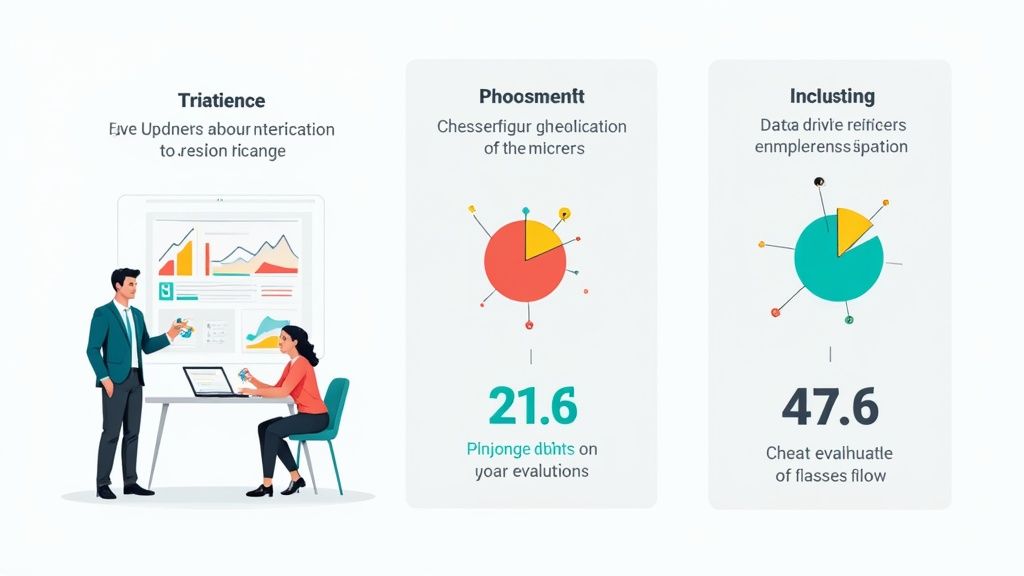Measuring Coaching Effectiveness: Proven Strategies


Why Most Coaching Programs Fail to Prove Their Worth

Organizations frequently invest heavily in coaching programs, anticipating a noticeable return on investment. However, demonstrating the actual value of these initiatives often proves challenging. Many organizations rely on surface-level metrics that don't accurately reflect the true impact of coaching. This reliance often leads to programs being deemed unsuccessful, even when they provide real value.
The Problem With Vanity Metrics
Many organizations track vanity metrics, such as the number of coaching sessions or participants. While these numbers might appear positive, they don't necessarily translate to improved performance or tangible business results. A high number of sessions, for instance, could indicate inefficiency, with coaches spending excessive time on easily resolved issues.
Furthermore, coaching's influence extends beyond the professional sphere. Research by UK Coaching emphasizes the positive correlation between coaching and well-being, including sustained engagement in various activities. This connection highlights the role of coaching in promoting both mental and physical health.
Focusing on the Wrong Outcomes
Another frequent oversight is prioritizing short-term gains over long-term growth. A sales team, for example, might experience a temporary sales increase after a coaching program. However, if the coaching fails to address underlying skills gaps or ingrained behavioral patterns, these gains are unlikely to last. This emphasizes the importance of measuring coaching effectiveness not just immediately following a program, but also over an extended period.
The Need for a Holistic Approach
To accurately assess coaching effectiveness, organizations need a holistic approach. This involves connecting individual development with overall business objectives and moving beyond superficial metrics. Instead, focus on meaningful indicators like changes in behavior, skills enhancement, and demonstrable performance improvements.
Gathering qualitative data, such as employee feedback and observed behavioral shifts, offers valuable insight into coaching's real-world impact on individuals and teams. A well-defined measurement framework is crucial for proving the value of coaching initiatives and ensuring long-term, impactful results.
The Metrics That Actually Matter for Coaching Success

Simply collecting data isn't enough when evaluating coaching programs. We need to focus on the metrics that truly indicate coaching effectiveness. This means establishing a framework that links these metrics to specific coaching objectives and the overall organizational goals. This section will guide you through identifying the Key Performance Indicators (KPIs) that accurately reflect your coaching program's impact.
Balancing Quantitative and Qualitative Data
Measuring coaching effectiveness requires a balanced approach, combining quantifiable metrics with qualitative insights. This provides a comprehensive understanding of the program's impact. Quantitative measures offer concrete data, while qualitative measures add context and depth.
For instance, tracking productivity improvements offers measurable proof of coaching's influence on work output. However, pairing this with qualitative feedback on participant satisfaction creates a more complete picture. This reveals how coaching affects both performance and overall well-being.
Similarly, measuring behavior change frequency can show how well coaching leads to real action. Combining this with confidence level assessments offers insight into how coaching fosters lasting personal growth.
The Balanced Scorecard Approach
Many organizations use a balanced scorecard approach to assess the diverse impact of coaching programs. This method integrates several perspectives:
- Financial: How does coaching influence profit, revenue, or cost savings?
- Customer: Does coaching lead to better customer satisfaction or loyalty?
- Internal Processes: How does coaching impact efficiency, productivity, and quality?
- Learning & Growth: Does coaching enhance employee skill development, retention, and engagement?
This multi-pronged approach offers a more holistic view of coaching's effects, going beyond individual performance to encompass wider organizational benefits. It also highlights areas for improvement by pinpointing metrics where coaching might be underperforming.
Selecting the Right Metrics
The right metrics depend on your coaching program's unique aims. Commonly used metrics include:
- Improved Performance: This is measured through objective performance data like sales figures, project completion rates, or quality scores.
- Increased Retention Rates: This metric tracks the percentage of employees who stay with the company after coaching.
- Enhanced Engagement: This can be evaluated through surveys, feedback, and by observing employee involvement and enthusiasm.
- Improved Leadership Skills: This is often measured with 360-degree feedback, self-assessments, and by observing leadership behaviors.
- Stronger Relationships: This can be assessed through feedback, surveys, and by observing improved communication and teamwork.
To provide a clearer overview of choosing effective coaching metrics, let's look at the table below. It highlights the different categories, specific measures, and their difficulty of implementation and predictive power.
Essential Coaching Effectiveness Metrics
A comprehensive overview of key metrics organized by category to help organizations select the most relevant indicators for their coaching programs
| Metric Category | Specific Measures | Implementation Difficulty | Predictive Value |
|---|---|---|---|
| Financial | Return on Investment (ROI), Cost Reduction, Revenue Growth | High | High |
| Customer | Customer Satisfaction Scores, Net Promoter Score (NPS) | Medium | Medium |
| Internal Processes | Productivity Improvement, Project Completion Rates, Quality Metrics | Medium | High |
| Learning & Growth | Employee Engagement Scores, Retention Rates, Skill Development Assessments, 360-degree feedback | Low | Medium |
| Individual Performance | Goal attainment, behavior change frequency, confidence levels | Low | High |
| Relationships | Team dynamics assessments, communication effectiveness scores | Medium | Medium |
This table gives a good starting point for organizations looking to implement or refine their coaching measurement strategies. By considering the different metric categories, organizations can select the ones that best align with their coaching program goals and overall business objectives.
Moving Beyond Data to Actionable Insights
Effective measurement goes beyond just collecting data. The true value is in transforming that data into actionable insights. This involves analyzing the data to find trends, patterns, and areas where coaching is succeeding or falling short. These insights can then be used to adjust coaching strategies, personalize programs, and enhance the overall effectiveness of the coaching initiative. This constant cycle of improvement makes measurement a critical component of success, allowing organizations to continuously adapt their programs to ensure they deliver maximum value.
Gathering Meaningful Data Without Overwhelming Everyone

Effective coaching measurement starts with a well-defined data collection strategy. This involves gathering the right information at the right time, without overburdening coaches or participants. This section explores practical ways to capture meaningful data throughout the coaching process.
Timing Is Everything: Data Collection Points
Think of data collection as an ongoing process woven into the coaching experience. Four key points to consider are:
Before Coaching Begins (Baseline Data): Initial data collection establishes a benchmark to measure progress. This could involve surveys, interviews, or pre-existing performance data. This baseline snapshot is critical for showcasing the coaching's impact later on.
During the Coaching Process (Formative Data): This tracks progress toward goals, identifies any roadblocks, and allows for adjustments to the coaching strategy. Methods may include regular check-ins, journaling, or direct observation. This provides real-time feedback and facilitates adjustments to maximize effectiveness.
Immediately After Completion (Summative Data): Gather feedback immediately after the program ends to capture participants’ immediate impressions. Surveys, interviews, and focus groups can be valuable tools. This immediate feedback is essential for understanding the program’s short-term impact.
Long-Term Follow-Up (Impact Data): This stage assesses the lasting effects of the coaching. Follow-up surveys, performance analysis, and interviews conducted months later can reveal sustainable changes and offer a more complete picture of the coaching’s effectiveness.
Choosing the Right Tools for the Job
Different data collection tools have their own strengths and weaknesses. Selecting the right tools for your specific needs and context is crucial.
Surveys: Surveys offer a quick and cost-effective way to collect data from a large number of participants. Ensure your survey design is clear, concise, and avoids jargon.
Interviews: In-depth interviews provide rich qualitative data offering deeper insights. They are more time-intensive and require skilled interviewers.
Observation Techniques: Direct observation of coaching sessions provides valuable real-world insights, but it can be disruptive if not handled carefully.
Performance Data Integration: Linking coaching to tangible business results, such as sales figures or project completion rates, is essential for demonstrating ROI.
Digital Analytics Tools: Various platforms offer automated data collection and analysis, streamlining the process and reducing administrative burden.
Ensuring Data Quality and Boosting Response Rates
High-quality data is paramount. Consider these key points:
Boosting Response Rates: Incentivize participation, personalize communication, and keep surveys short and focused to encourage higher response rates.
Ensuring Data Quality: Clearly communicate the purpose of data collection, guarantee anonymity where appropriate, and utilize validated instruments.
Building Automated Systems: Automate data entry and analysis to reduce manual work, minimize errors, and improve efficiency and data accuracy.
Statistical Considerations: Statistical analysis is critical for measuring coaching effectiveness, but requires careful attention to sample size and effect size. A large sample size is often necessary for reliable results, particularly when the effect size is small. For example, large-scale surveys, like those by UK Coaching, offer valuable insights. Learn more about the relationship between sample size and its effects.
By implementing these strategies, you can create a robust measurement system that captures the true value of your coaching programs, without adding unnecessary workload. This enables a data-driven approach to continuous improvement, ensuring your coaching delivers lasting results.
Calculating ROI That Executives Actually Care About

Demonstrating the tangible value of coaching is essential for securing executive buy-in and ongoing investment. Moving beyond subjective impressions requires a structured approach to calculating Return on Investment (ROI) that resonates with business leaders. This section provides a framework for quantifying the impact of coaching and building a compelling business case.
Quantifying Hard and Soft Benefits
Measuring coaching effectiveness means considering both hard benefits and soft outcomes. Hard benefits, such as improved productivity and increased sales, are readily quantifiable and often translate directly into financial gains. For example, a coaching program focused on sales techniques could lead to a measurable increase in sales revenue.
Soft outcomes, while less easily quantifiable, are no less important. These include enhanced employee engagement and better decision-making. Improved engagement can reduce turnover, minimizing recruitment and training costs. Enhanced decision-making can lead to more successful projects and strategic initiatives.
Quantifying these soft outcomes often involves linking them to measurable business results. This could involve tracking employee retention rates or project success rates. Connecting these soft improvements to concrete business outcomes demonstrates their value.
Real-World Examples of Demonstrated ROI
Many leading organizations have effectively linked specific business results to their coaching initiatives. A manufacturing company might attribute a decrease in production errors to a coaching program focused on problem-solving skills. A customer service team could experience improved customer satisfaction scores following coaching that targets communication and empathy. These real-world connections provide solid evidence of coaching's positive influence.
Frameworks for Isolating Coaching Impact
Isolating the impact of coaching from other organizational factors is key for accurate ROI calculation. This requires establishing clear baseline measurements before coaching begins. Then, performance data is compared after the coaching intervention.
This comparison helps isolate the impact of coaching from other variables. These variables could include changes in market conditions or the introduction of new technologies. For instance, if a company implements a new software system alongside a coaching program, establishing baseline sales figures beforehand allows for a more accurate assessment of each initiative's individual impact.
A Practical Framework for ROI Calculation
Calculating ROI means measuring the financial return on the investment in coaching. The following table provides a structured approach. It outlines the key components of ROI calculation, how to calculate them, and common challenges. This framework provides a clear roadmap for quantifying the value of your coaching programs.
To help illustrate the process, let's explore a practical framework. The following table, "Coaching ROI Calculation Framework," breaks down the calculation step by step:
Coaching ROI Calculation Framework
Step-by-step approach to calculating the financial return on coaching investments, including formulas and examples
| ROI Component | Calculation Method | Data Sources | Common Challenges |
|---|---|---|---|
| Program Costs | Total cost of coaching (fees, materials, administrative expenses) | Budget reports, vendor invoices | Accurately capturing all associated costs |
| Program Benefits | Quantified financial gains (increased sales, reduced costs, improved productivity) | Performance data, financial reports | Isolating the specific impact of coaching |
| ROI Calculation | (Benefits - Costs) / Costs x 100 | Calculated from program costs and benefits | Attributing indirect benefits like improved decision-making |
By implementing this framework and consistently tracking relevant metrics, organizations can demonstrate the tangible value of their coaching programs. This data-driven approach to measuring coaching effectiveness not only showcases the return on investment but also helps secure continued support for developing employees. This empowers organizations to invest strategically in their people and drive meaningful business results.
Measuring Coaching Through a Diversity and Inclusion Lens
Truly effective coaching programs must benefit all participants, regardless of background. This requires evaluating coaching effectiveness through a diversity and inclusion lens to identify any potential disparities and ensure equitable benefits for everyone. This goes beyond simply assessing overall program effectiveness and delves into the experiences of specific demographic groups.
Disaggregating Data to Identify Gaps
A crucial strategy for inclusive measurement is disaggregating data. This involves breaking down coaching data by demographics like gender, race, ethnicity, age, and other relevant categories. Analyzing metrics like completion rates, satisfaction scores, and performance improvements separately for each group can uncover hidden disparities and provide a more nuanced understanding of program impact. This might reveal, for instance, that a certain demographic isn't experiencing the same benefits as others.
Recognizing Unconscious Biases in Measurement
Addressing unconscious biases is another critical aspect of inclusive measurement. These biases can subtly influence assessment design, data interpretation, and even participant selection. A performance metric that unintentionally favors a particular work style, for example, might disadvantage individuals from different cultural backgrounds. Regularly reviewing measurement approaches for potential biases is essential for equitable coaching programs.
Furthermore, understanding the demographics of coaches themselves is important. In the UK, the percentage of female coaches decreased from 44% to 38% between 2022 and 2024. This 6% decline highlights the need for greater inclusivity within the coaching profession itself. More detailed statistics on coaching demographics in the UK underscore this point.
Culturally Sensitive Assessment and Inclusive Metrics
Developing culturally sensitive assessment tools is vital for measuring effectiveness across diverse groups. This involves ensuring that assessment questions, scenarios, and criteria are relevant and appropriate for all participants, considering language barriers, cultural nuances, and varying definitions of success. This means adapting assessments to different cultural contexts, not just translating them. It also means creating inclusive metrics that recognize different perspectives on achievement.
For example, the concept of "leadership" can vary across cultures. Using a single, narrow definition in assessment tools might not accurately reflect the leadership potential of individuals from diverse backgrounds. A broader, more nuanced definition, or incorporating multiple perspectives, allows for a more inclusive evaluation.
Measuring Contributions to Equitable Environments
Finally, measuring coaching effectiveness through a diversity and inclusion lens should also consider how coaching promotes more equitable environments. This might involve tracking changes in workplace culture, promotion rates, or leadership representation. This can provide valuable insights into how coaching programs support broader diversity and inclusion goals. For instance, coaching programs focused on inclusive leadership could be evaluated by measuring changes in employee perceptions of inclusion.
By implementing these strategies, organizations can ensure their coaching programs are truly effective for everyone, fostering inclusivity and maximizing the potential of all participants. This approach is fundamental to achieving meaningful and equitable outcomes.
Technology That Transforms Coaching Measurement
Measuring coaching effectiveness has moved beyond manual processes and subjective feedback. Technology now plays a vital role in how we gather, analyze, and interpret data, offering more profound insights than ever before. This section explores the evolving role of technology in enhancing our understanding and improvement of coaching programs.
From Feedback Platforms to AI-Powered Analytics
The technology available for measuring coaching effectiveness spans a wide spectrum, from simple feedback platforms like SurveyMonkey to sophisticated analytics systems. Basic platforms facilitate survey creation and automate data collection, giving coaches more time to focus on their clients.
More advanced systems incorporate AI and machine learning, allowing for deeper analysis of qualitative data. These systems can identify recurring patterns and themes within feedback, providing insights that might otherwise be overlooked. This elevates coaching measurement from simple data gathering to uncovering actionable insights.
Technology for Every Stage of the Coaching Journey
Technology supports data collection and analysis across the entire coaching process. A variety of tools are available for different stages:
- Tracking Coaching Sessions: Platforms can log session durations, topics covered, and goals established, creating a comprehensive record of the coaching journey.
- Monitoring Goal Progress: Apps and software solutions allow coaches and participants to track progress towards goals in real-time, promoting accountability and enabling adjustments as needed.
- Analyzing Communication Patterns: AI-powered tools can analyze email and chat communications to identify patterns and provide insights into communication styles and potential areas for improvement.
- Identifying Behavioral Changes: Technology can track behavioral changes through self-assessments, feedback from colleagues, and performance data, offering a more holistic view of individual development.
Leveraging Natural Language Processing and Predictive Analytics
Natural Language Processing (NLP) empowers organizations to analyze qualitative feedback, such as open-ended survey responses or interview transcripts. This technology identifies key themes and sentiments within the text, providing a deeper understanding of the coaching experience.
Predictive analytics uses historical data to forecast future outcomes. This can be useful for predicting the likelihood of coaching success or identifying individuals who might benefit most from specific types of coaching.
Choosing the Right Tools for Your Needs
Selecting the appropriate technology depends on several factors:
- Organizational Maturity: Organizations new to coaching measurement may want to start with basic feedback platforms before investing in more complex analytics systems.
- Integration Needs: Ensuring compatibility with existing HR and performance management systems is essential for streamlined data flow and analysis.
- Specific Coaching Objectives: Different tools offer various features and functionalities. Choose tools that align with the specific goals of your coaching program.
Careful consideration of these factors helps organizations select technology that effectively measures coaching effectiveness.
Case Studies: Innovation in Coaching Measurement
Organizations are increasingly using technology to gain a deeper understanding of coaching effectiveness. Some use AI to personalize coaching programs, tailoring content and approaches to individual needs. Others integrate performance data with coaching feedback to demonstrate a direct link between coaching and business outcomes. These case studies provide valuable examples of how technology can enhance coaching measurement.
For instance, some companies use sentiment analysis tools to assess participant satisfaction and identify areas for improvement in coaching programs. Other organizations use machine learning to analyze performance data and identify individuals who would benefit from targeted coaching interventions. These real-world examples highlight the power of technology to transform coaching measurement and drive positive change.
By embracing technology, organizations can move beyond basic data collection to gain more nuanced insights. This unlocks the full potential of coaching, turning measurement into a driver of improvement and maximizing its value.
Building a Culture Where Measurement Drives Improvement
Measuring the effectiveness of coaching isn't a one-off task; it's a continuous process. Successful coaching programs integrate measurement into their core, creating a cycle of ongoing improvement. This section explores how to cultivate this type of culture, where data is not simply gathered, but actively used to guide program development and demonstrate tangible results.
Creating Learning Loops: From Insight to Action
Imagine a feedback loop where data directly shapes program adjustments. This is the essence of a measurement-driven culture. It's about building a system where data analysis pinpoints strengths, weaknesses, and opportunities, leading to concrete changes in coaching strategies, content, and delivery. For example, if data shows participants consistently struggle with a specific skill, the program can be modified to offer more targeted support in that area.
Empowering Coaches to Embrace Measurement
Coaches are vital to this data-driven approach. They need training not only to deliver coaching, but also to understand the importance of effectiveness metrics. This includes interpreting data, recognizing trends, and using these insights to refine their coaching methods. This empowers coaches to take ownership of the measurement process and contribute to the program's ongoing development.
Establishing Governance Structures for Accountability
A culture of measurement needs clear accountability. This means establishing a governance system that defines roles, responsibilities, and reporting procedures related to data collection, analysis, and action planning. This ensures measurement is a core component of the program, not an afterthought. This system could include regular review meetings to discuss data findings and make program adjustments.
Celebrating Wins and Addressing Improvement Areas
Acknowledging both successes and areas for improvement is essential. Celebrating positive outcomes reinforces coaching's value and encourages continued participation. Simultaneously, addressing shortcomings openly promotes a culture of continuous learning and improvement. This balanced approach creates a positive feedback loop, motivating ongoing engagement and driving program enhancement.
Maintaining Executive Support Through Demonstrated Impact
Sustaining executive buy-in requires demonstrating coaching's tangible impact. By showcasing how coaching contributes to key business outcomes, such as increased productivity or improved employee retention, you can build a strong case for continued investment. Regularly communicating coaching's value to executives reinforces its importance and ensures ongoing support. This could involve preparing regular reports highlighting key metrics and demonstrating the program's ROI.
Building a Dynamic and Evolving System
Organizational priorities and business needs are constantly changing. A successful coaching program must be dynamic and adaptable, evolving alongside these shifting demands. This includes regularly reviewing and updating the program's objectives, metrics, and delivery methods to ensure they remain relevant and effective. This adaptability is key for long-term value.
By creating a culture where measurement fuels improvement, organizations can unlock their coaching programs' full potential. This approach transforms measurement from a routine task to a strategic asset, driving continuous growth and maximizing impact.
Are you ready to transform your coaching program into a data-driven engine of growth? Visit Coaching Hub for resources, insights, and tools to measure coaching effectiveness and build a culture of continuous improvement.